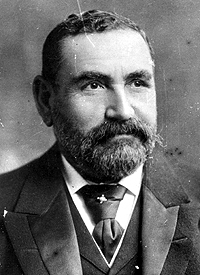South Sydney was an electoral district for the Legislative Assembly in the Australian state of New South Wales from 1880 to 1894, covering the southern part of the current Sydney central business district, Haymarket, Surry Hills, Moore Park and Chippendale, bordered by George Street, Broadway, City Road, Cleveland Street, South Dowling Street, Dacey Avenue, the western edge of Centennial Park, Moore Park Road, South Dowling Street, Oxford Street and Liverpool Street. It elected four members simultaneously, with voters casting four votes and the first four candidates being elected. For the 1894 election, it was replaced by the single-member electorates of Sydney-Phillip, Sydney-Belmore, Sydney-Flinders and Sydney-Cook.
The Speaker of the Western Australian Legislative Assembly is the presiding officer in the Legislative Assembly. The office has existed since the creation of the Legislative Assembly in 1890 under the Constitution Act 1889. The 31st and current Speaker is Labor MLA Michelle Roberts, who has held the role since the 2021 state election.
Members of the New South Wales Legislative Assembly who served in the 14th parliament of New South Wales held their seats from 1889 to 1891. They were elected at the 1889 colonial election between 1 and 16 February 1889. The Speaker was James Young until 21 October 1890 and then Joseph Palmer Abbott.
Members of the New South Wales Legislative Assembly who served in the 13th parliament of New South Wales held their seats from 1887 to 1889. They were elected at the 1887 colonial election between 4 and 26 February 1887. The Speaker was James Young. This was the first parliament to have recognizable party groups.
The Parliament of British Columbia is made of two elements: the King of Canada in Right of British Columbia, represented by the lieutenant governor, and the Legislative Assembly of British Columbia. The Parliament of British Columbia has existed since the province joined Canada in 1871, before which it was preceded by the Parliament of the United Colony of British Columbia.

The second Dibbs ministry was the 25th ministry of the Colony of New South Wales, and was the second of three occasions of being led by the tenth Premier, George Dibbs. Dibbs was elected to the New South Wales Legislative Assembly in 1874. In a period of great financial stress for the Colony, this ministry covers just 49 days from 17 January 1889 until 7 March 1889. Dibbs took over as Premier on the first occasion in October 1885 following resignation of the Alexander Stuart due to ill-health, with his ministry lasting for 75 days. Dibbs served as Colonial Secretary in the Jennings ministry, before it too suffered budgetary pressures. It was during this time that the party system was formed in New South Wales with Sir Henry Parkes leading the Free Trade Party. Dibbs had been elected as an independent free trader, however his opposition to Parkes caused Dibbs to align himself with the Protectionist Party. Dibbs had assumed office when Parkes lost a vote on the floor of the Assembly. Parliament was dissolved on 19 January 1889 and an election was held in February. There was a significant swing to the Protectionists, gaining 29 seats, however it was insufficient to command a majority of the Legislative Assembly and Parkes resumed the premiership.

The See ministry was the 30th ministry of the New South Wales Government, and was led by the 14th Premier, Sir John See. The title of Premier was widely used to refer to the Leader of Government, but was not a formal position in the government until 1920. Instead the Premier was appointed to another portfolio, usually Colonial Secretary.

East Bourke Boroughs was an electoral district of the Legislative Assembly in the Australian state of Victoria from 1859 to 1904.
This is a list of members of the Victorian Legislative Assembly, from the elections of 28 March 1889 to the elections of 20 April 1892. There were 95 seats in the Assembly from 1889, up from 86 in the previous Parliament.
This is a list of members of the Victorian Legislative Council from the elections of 31 August 1888 to the elections of 11 September 1890.
This is a list of members of the Victorian Legislative Council from the elections of 8 September 1892 to the elections of 12 September 1895. No seats were contested in the elections of 13 September 1894.
Members of the New South Wales Legislative Council who served from 1889 to 1891 were appointed for life by the Governor on the advice of the Premier. This list includes members between the elections commencing on 1 February 1889 and the elections commencing on 17 June 1891. The President was Sir John Hay.
The 1843 New South Wales colonial election was held between 15 June and 3 July 1843. This election was for 24 seats in the New South Wales Legislative Council and it was conducted in 15 single-member constituencies, two 2-member constituencies and one 5-member constituency, all with a first past the post system. This included 6 members in what became the Colony of Victoria and a single member for the coast north of Newcastle. The Legislative Council was a hybrid system with 36 members, 24 elected, 6 appointed by virtue of their office and 6 nominated. The appointments and elections were for five year terms.
The 1848 New South Wales colonial election was held between 29 July and 2 August 1848. This election was for 24 seats in the New South Wales Legislative Council and it was conducted in 15 single-member constituencies, two 2-member constituencies and one 5-member constituency, all with a first past the post system. The Legislative Council was a hybrid system with 36 members, 24 elected, 6 appointed by virtue of their office and 6 nominated. The appointments and elections were for five year terms.<